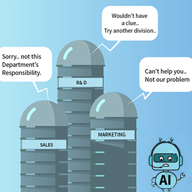Guide to flawless digital transformation

Digital & Technology
311 week ago — 9 min read
Background: Digital transformation is described as a profound transformation of existing business models, processes and organisational activities by embracing new digital technologies. In his previous article, Kendrick Bradney De Figueiredo Melo talked about achieving the 'flow state' at work. Here he explains practical tips to achieve digital transformation.
Digital Transformation is the culmination of more than 50 years of technological advancements in IT (Information Technology). It began in the 1960s and 1970s as computing and telecommunications strategy, a journey with the capabilities of growing exponentially. These capabilities enable businesses to perform their tasks in a better, faster and cheaper way. Earlier, the tech was mainly appointed for streamlining business operations and augmenting them, but it did not have a huge impact on the business model as a whole.
Ever since the advent of advanced computing and communication infrastructure such as cloud computing and software dominated networks, businesses have the opportunity to embrace a radical shift. Now, instead of opting for minor technology such as the likes of extended support to existing software, it’s used in rethinking fundamental business models from the ground up. This is possible as the tech is readily available and easy to implement. This is digital transformation, which enables a business to revolutionise processes.
Ever since the advent of advanced computing and communication infrastructure such as cloud computing and software dominated networks, businesses have the opportunity to embrace a radical shift.
As popular as it is now, the concept is still quite hazy and thus risks the chance of being marketed wrong. It is extremely important to understand the hype around the concept. 95% of organisations believe that a digital workplace is important. In addition to that, approximately 44% of workplaces have some form of digital workplace programmes in place.
It is also important to understand what drives organisations to opt for digital transformation. 48% of organisations reported that adopting cloud services has provided them with a better cost model and so much as 73% of organisations say nearly all their apps will be SaaS by 2020.
Also read: Why digital transformation is the key to your survival in a competitive world
Now to discuss how to flawlessly transform your workplace, here are a few pointers for you:
Conduct trial runs
Digital transformation is not the easiest to get right the first time, especially in highly uncertain and complex environments. It is indeed extremely important, as most companies see digital transformation as being key to the very survival for their business. Trying a few things to see what works and specifically allowing for serendipity can be a strong strategic approach. By conducting trial runs, a business can build a picture of how to influence a highly dynamic environment.
Examples
- Digital labs: Having a digital lab in which it is possible to play with new technologies without having an immediate business case. Think of the Internet of Things (IoT), 3D printing or advanced analytics. In this lab, new possibilities are explored.
- Evolving customer experience and engagement: This may have an overarching objective, but the way forward is likely murky and requires constant experimentation, validation, and nimble thinking.
- The commercial aspects of digital business models: These are not always easy to determine. What is the right price to charge? Beta tests with customers and other stakeholders help determine what truly adds value, substantiating a pricing strategy and market acceptance.
Generate alternatives
How do you know that your choice will still be the right choice when the business environment changes? Given the often irreversible nature of large investments such as setting up a digital platform, the gap between the technology planning and the investment life cycle poses a significant strategic risk. Thus, making large investments challenging in a dynamic environment.
Alternative based strategies are derived from the same concept that the future is uncertain. They are incredibly flexible and diverse. As specific use cases are assumed to be unpredictable, this strategy just describes the principles for each emerging use case to adhere to. New strategic initiatives can be added to, moved or removed from the list at any moment.
Also read: Digital Transformation: The new normal
Examples
- Business moments: Instead of defining digital processes as a sequence of steps toward a predetermined goal, "business moments" are defined as sets of interactions toward a negotiated goal. A business moment sets the conditions in which unscripted interaction can take place.
- The cloud: This provides an options-based approach because it can scale elastically. It keeps your computer and storage options open.
- Data virtualization technologies: These allow data to be left where it lives, without having to build elaborate data integration structures. Data can be accessed and integrated, given the proper master data, on the spot. Should this be too slow or cumbersome, a more thorough process can follow later.
Make decisions
The classic view of strategy — that it's based on clear choices over what you do and what you don't do, is well in situations where there is high certainty for instance, where you have clear control over your environment, and where decisions are highly irreversible.
There can be a clear separation between strategy formulation, execution, and feedback, as the roadmap is clear. In fact, a straightforward, sequential waterfall implementation is most probably the fastest and least expensive method.
Examples
Most of IT is used to working like this, including when implementing enterprise business applications, data warehouses and office automation. These practices have not gone away, but the number of projects that operate under choice-based conditions — high certainty, high irreversibility — is decreasing.
Improving the current state of affairs
Keeping the current status —actively deciding to not change something— often sounds like an anti-strategy, but there are certain reasons why it might just work for you.
First, keeping your existing solutions allows you to focus on improving efficiency and thereby drive down cost, allowing for more resources in other, more important priorities. It makes the most sense to spend as little time as possible on some activities, as they do not differentiate.
Second, as you can reverse your decision at any time, it allows you to "wait and observe”. Steve Jobs once said, "I am going to wait for the next big thing." This was in 1998. A few years later, the iPod was introduced — the starting point for Apple's renewed success. Jobs maintained the status quo, waited and observed the market, and, when the time was right, focused on the new opportunity.
Examples
Every organisation needs functions such as financial consolidation, management reporting, traditional data management, and other things to keep the lights on. By minimising the cost and effort it takes to maintain these functions, organisations can free up the resources for more-valuable initiatives.
The time for the digital transformation of your business is now. Don’t wait. Focus on your customer and rely on an experienced consulting partner. Embed a digital mindset within your entire organisation and understand that business transformation is a journey that will constantly evolve as you embrace future innovations.
Also read: How can SMEs adopt digital transformation?
Image source: shutterstock.com
To explore business opportunities, link with me by clicking on the 'Connect' button on my eBiz Card.
Disclaimer: The views and opinions expressed in this article are those of the author and do not necessarily reflect the views, official policy or position of GlobalLinker.
Posted by
Kendrick Bradney De Figueiredo MeloDigital Transformation and Social Collaboration for Businesses. Simple and Agile Digital Workplace. A seamless way to market, sell, support and manage your organization.
View Kendrick 's profile
SME Inspirations
Other articles written by Kendrick De Figueiredo Melo
Productivity in the age of information overload
306 week ago
SaaS Platform - A smart way to run & grow business
309 week ago
Most read this week















Comments
Share this content
Please login or Register to join the discussion